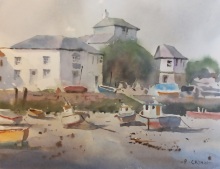On 6th October we were treated to a brilliant watercolour painting demonstration by awarding-winning artist Peter Cronin, a well-known and respected judge from Watercolour Challenge.
On a pre-drawn pencil drawing of a Megagissy water scene on Sanders Waterford cold pressed 300lb paper, he began with a wash for the sky using ultramarine and burnt sienna, advocating what he calls a “60 second sky”, in other words, getting it down quickly. Working from the top down and the board to allow the runs to move down, working as he moves down the paper adding soft washes to complete the first layer over the whole paper, adding in a little red to the wash.

Peter told us how he aims to do a whole painting in two layers, three at most with stronger, stiffer paint applied in the foreground to achieve recession. Broken down into simple elements: the first wash is where light strikes; shadows and verticals formed in the second wash. One of his many mantras for painting being “indicate, don’t state.” A painting should express feeling, contrast and light, as opposed to an illustration which shows everything that is there.

Whilst the first wash dried, he showed examples from his sketchbook, mostly done plein air, some even from the comfort of his car when too wet to be outdoors, explaining how even in a simple sketch, two layers are there: the outline the first, hatching the second.
Removing the small amounts of masking fluid used on the initial drawing, Peter added the second layer or “pass” by painting the shapes, not the actual objects, creating soft edges and “walking” the paint into the shapes. Whilst one area dried, he worked on a different part of the scene, changing the colour in the washes to create repetition with variation in order to bring the picture to life. This became clear as he added in the windows on the buildings, each window reveal different from the next, using simple strokes.

With a small brush items such as the boats in this scene were painted in with tone more than colour. When painting the boats’ reflections in the water, he leaves no gaps between the two, painting in the reflection at the same time as any edges are painted, treating each one as a single object. In some areas of the painting he added a glaze of ultramarine and a touch of violet to darken tones he felt were too light and to darken the foreground.
Like many of us when we paint, it is often difficult to judge when the work is finished. Peter also has this dilemma. For him, any sketch or painting begins with the title. When the painting says the title, that it when it is finished.
His humour and relaxed style made for an entertaining and most-enjoyable afternoon.


You must be logged in to post a comment.